The World Suicide Prevention Day is an awareness day, taking place every year on the 10th of September, with an aim to reduce the rate of suicides.
According to the World Health Organization (WHO), every 40 seconds a person dies by suicide. Suicide can be attempted by everyone, no matter the socioeconomic background, nationality or place of residence, and they are an occurrence in all parts of the world. At the same time, Europe has the highest average rate of suicides.
In the age group of 15 to 29, suicide is the second leading cause of death, based on data from the WHO. It has been found out that nine out of ten people who commit suicide have a mental illness, with the majority suffering from depression, anxiety or eating disorders. At the same time, half of the mental health illnesses begin at the age of 14, but most of them are not diagnosed and therefore not treated. Consequently, young adults are the target group to focus on, if we want to reduce the rate of suicides.
Also according to the WHO, mental health is “a state of well-being in which the individual realizes his or her own abilities, can cope with the normal stresses of life, can work productively and fruitfully, and is able to make a contribution to his or her community”. When mental health problems are persistent, they turn into mental health illnesses, also known as disorders. To lower the frequency of impactful mental health problems for young people, it is important to acknowledge the risk factors.
The onset of mental health problems is individual for everyone affected. It can be rooted in childhood or acquired due to specific factors. One of the most common risk factors for young people is high standards and expectations in the educational system. By measuring academic performance with grades and awards, young people are put under constant pressure, that results in stress and anxiety. As young adults finish secondary education, they transition into adulthood and have to establish a stable sense of independence and identity. Balancing further education, finances, everyday chores and extra-curricular activities, such as volunteering, it is a challenge for youth to maintain mental health well-being.
As more than half of the users of diverse social platforms are young adults, negative media influence is another source of a possible risk factor for mental health issues. The unachievable images of the body, relationships and success portrayed in the media lead to constant comparison and reduced self-worth among the young people. Furthermore, the internet, due to its wide availability, is the place to exchange views and ideas, especially popular among young individuals and groups of like-minded people. However cyberbullying, hate-speech and public shaming are the major downsides, potentially leaving a negative long-term impact on mental health.
An individual might deal with their mental health problems on their own, but mental health disorders often require professional help. Unfortunately, many young people do not seek help, as there is an overall stigma concerning these issues. It is crucial to raise awareness around mental health to reduce the negative beliefs and attitudes and provide professional help. We acknowledge, that there has indeed been an increased awareness on the topic of suicide. However, examples, in popular media such as the Netflix TV-Show “13 Reasons Why”, which tackles the topic of mental health of youth, have produced controversial statistics. There are studies claiming that after the first season of “13 Reasons Why” was published, the rate of suicides increased significantly. At the same time, there is empirical evidence that highlights the success of the show and its educational purposes. In spite of the true impact of using popular media channels to talk about suicide not being definite, the data underlines the importance of deliberate actions to tackle this sensitive and often triggering topic.
AEGEE-Europe highlights the importance of transversal skills and competences, including the awareness of mental health. It is necessary to inform youth on how to recognize, manage and prevent mental health illnesses. The knowledge is vital not only for the person affected by the mental illness but also for their surrounding, such as relatives and friends. Furthermore, the importance of accessible and affordable, long-term professional help in the form of a counsellor and/or psychologist is a key chance to improve mental health and thus reduce the rate of suicides.
Therefore AEGEE-Europe demands, that
- Governments recognize the importance of mental health literacy among youth.
- Governments and educational institutions work together to provide professional help on mental health problems without additional costs in all educational institutions.
- Employers establish workplaces as mentally safe environments by either employing a mental-health professional at the workplace or covering costs if such specialist has been attended outside of the workplace.
Furthermore, we urge all Member States to implement the Council of Europe’s recommendations on ending coercion in mental health to respect human rights and improve mental health practice. Adopted in 2019, it consists of various measures, including awareness-raising activities and increased availability of resources and services for both medical institutions and people with mental health illnesses.
Sources:
- https://www.who.int/mental_health/prevention/suicide/suicideprevent/en/
- https://www.healthychildren.org/English/health-issues/conditions/emotional-problems/Pages/Which-Kids-are-at-Highest-Risk-for-Suicide.aspx
- http://apps.who.int/gho/data/node.sdg.3-4-viz-2?lang=en
- https://time.com/5550803/depression-suicide-rates-youth/
- https://www.healthychildren.org/English/family-life/Media/Pages/Talking-About-13-Reasons-Why-Teen-Suicide.aspx
- https://www.mhe-sme.org/wp-content/uploads/2019/08/Young-People-and-Mental-Health-Infographic.pdf
- https://www.mind.org.uk/information-support/types-of-mental-health-problems/statistics-and-facts-about-mental-health/how-common-are-mental-health-problems/#.XXFuhygzbIU
- https://www.nimh.nih.gov/health/statistics/mental-illness.shtml
- https://www.statista.com/statistics/274829/age-distribution-of-active-social-media-users-worldwide-by-platform/
- https://www.healthychildren.org/English/health-issues/conditions/emotional-problems/Pages/Ten-Things-Parents-Can-Do-to-Prevent-Suicide.aspx
- https://www.who.int/features/factfiles/mental_health/en/
- http://assembly.coe.int/nw/xml/News/News-View-EN.asp?newsid=7545&lang=2&cat=8
- https://www.who.int/news-room/fact-sheets/detail/adolescent-mental-health






